Winter Solstice and Chanoyu
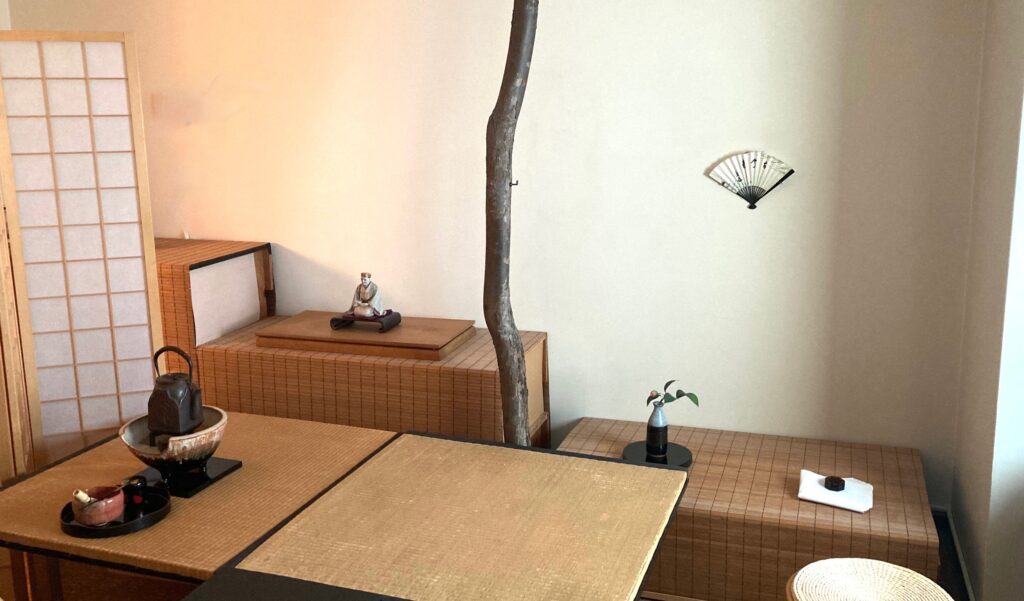
Garandō set for presenting Bon-ryaku Ten-mae, 盆略点前, Tray-abbreviate Offer-fore, on the occasion of the winter solstice, Tō-ji, 冬至, Winter-attain.
Tokonoma: sen-su, 扇子, fan-of; silk camellia in a ceramic bottle, hana-ire, 花入, flower-receptacle; displayed on a black-lacquered round board; kō-gō, 香合incense-gather, black-lacquered, octagonal, covered wooden box displayed on a kami-kama-shiki, 紙釜敷, paper-kettle-spread.
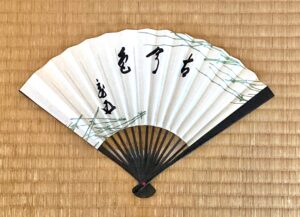
Sen-su, 扇子, fan-of, white paper with blackened bamboo ribs, with calligraphy, ‘Ko–kon-shiki’, 古今色, Past-preset-color, by Hō-un-sai, 鵬雲斎, Phoenix-cloud-abstain, XV Iemoto, Urasenke. The word, kokon, is drawn from the Zen expression, 松無古今色 , pine no past present color, which is read, ‘Matsu ni Ko-kon Iro Nashi’.
The sensu has thirteen black ribs independent of the two covers. The number thirteen may evoke the Jū-san Butsu, 十三仏, Ten-three Buddhas, who are guardians of thirteen periods of mourning. The design of two-tine pine needles, matsu-ba, 松葉, pine-leaf, like the folding fan itself and the paper folds are emblematic of Infinity in Space, sue-hiro, 末広, ends-wide.
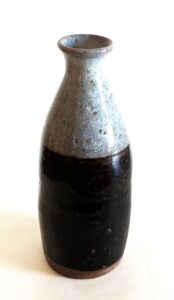
To-kkuri, 徳利, virtue-profit, ceramic sake bottle, used as a hana-ire, 花, flower-receptacle, with black and white glazes, Chō-sen Kara-tsu Yaki, 朝鮮唐津焼, Morning-clear Tang-port Fired; H. 6 sun kane-jaku.
The piece was chosen for the solstice because its glaze is half white and half black, and is evocative of In and Yō, 陰陽, Yin Yang, negative positive. The winter solstice, according to Asian symbolism, is the extreme limit of the aspect of In, and the beginning of the increase of the aspect of Yō, which attains its extreme aspect at the summer solstice, ge-shi, 夏至, summer-attain.
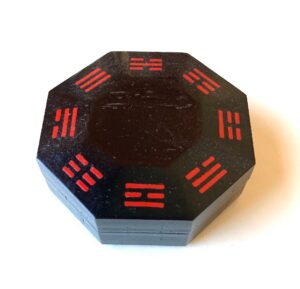
Kō-gō, 香合incense-gather, black-lacquered, octagonal, covered wooden box with red lacquered motifs of the ha-kke, 八卦, eight-signs, from the Eki-kyō, 易経, Change-sutra. Intended to hold byaku-dan, 白檀, white-sandalwood. Red and black are colors that are believed to repel evil.
The pictured kōgō is for use with furo, and it should be understood that the furo can be used year-round, often when there is no ro. Regardless of the season, the bin-kake is like a furo, and Rikyū wrote that byakudan is used with the furo.
The Ekikyō establishes various aspects of Chanoyu and Asian culture. It is essential in the orientation of the room and the placement of utensils, and the nature of each of the Tea utensils. The circle of the Ha-kke, 八卦, Eight-signs, establishes the center of the world, and for Tea people, the yojōhan is the center of the world.
The Ekikyō trigram for Water, Kan, 坎, Abyss, is at the far side of the kōgō, and it is identified with the north, and Tō-ji, 冬至, Winter-attain, the solstice. It is the design written on the ash of the furo before the fire is placed in the hearth. In the yo-jō-han, 四畳半, four-mat-half, the influence of Water is manifest in the hana-ire that sustain flowers for Tea. Various deities are depicted with water, such as Bishamonten. The earliest figure of Bishamonten, presented by China, which is in the treasury of Tō-ji, 東寺, East-temple, depicts him standing above waves lapping at the base.
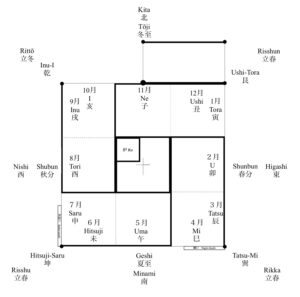
Diagram of a yo-jō-han cha-shitsu, 四畳半茶室, four-mat-half tea-room. The yojōhan is identified with the directions, with north, Kita, 北, at the top of the diagram, and south, Minami, 南, at the bottom of the diagram. The Tearoom is identified with the solar calendar year and the seasons, and the lunar calendar. The winter solstice, a solar event, in Japanese is called Tō-ji, 冬至, Winter-attain, and is located in the middle of the north wall, corresponding with the toko-bashira, 床柱, floor-post.
The summer solstice, Ge-shi, 夏至, Summer-attain, is located in the middle of the south wall. The vernal equinox, Shun-bun, 春分, Spring-divide, is located in the middle of the east wall, and the autumnal equinox, Shu-bun, 秋分, Autumn-divide, is in the middle of the west wall. The solstices divide the Tearoom into two parts, with the guest area in the eastern half, and the host area in the western half.
In Buddhism, Shintō, Taoism, etc. there are numerous deities, and various groupings may be identified with the yojōhan. According to Buddhism, the directions are identified with the Shi-ten-nō, 四天王, Four-heaven-kings, and eight guardian deities, and the Jū-ni-shi, 十二支, Ten-two-branches, twelve zodiac signs that they protect. One of the most important deities who protects the capital city is Bishamonten.
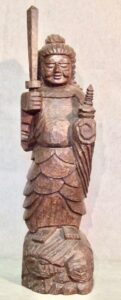

The roughly sculpted image of Bishamonten depicts him holding in his right hand the hōbō, that is depicted as a ken, 剣, sword. One of the styles of bamboo cha-shaku, 茶杓, tea-scoop, is called ken-saki, 剣先, sword-point (depicted above). The chashaku is wiped three times. Perhaps wiping the chashaku three times evokes the image of the three-prong trident of Bishamon, san-sa-sō, 三叉槍, three-fork-spear. The standard length of the chashaku is 6 sun kane-jaku.
Bishamonten is identified with the north and the winter solstice, and holds the hōbō, 宝棒, treasure-rod, in his right hand. Perhaps his hōbō is represented by the toko-bashira, 床柱, floor-post. The length of the hōbō of some early figures of Bishamonten are approximately 5.9 sun kane-jaku. The height of the ceiling of Rikyū’s yojōhan chashitsu is 5.9 sun kane-jaku.
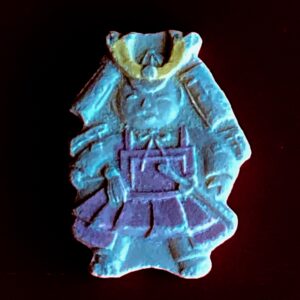
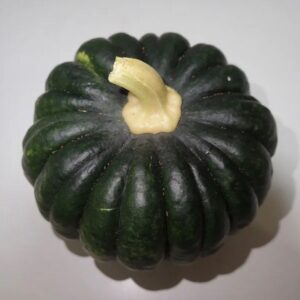
On the winter solstice, Tō-ji, 冬至, Winter-attain, Bishamonten is celebrated at shrines and temples throughout Japan. On the solstice, people eat cooked Japanese pumpkin, kabocha, 南瓜, south-melon, and in a soup, kabocha zen-zai, 南瓜善哉, south-melon good-how, a sweetened red bean soup made with azuki, 小豆, small-bean, with toasted mochi, and pieces of pumpkin.
Zenzai and pumpkin are eaten in mid-winter for good health. Like many popular foods, variations abound. The very popular kabocha skin is a very dark green color, and some are nearly black. The form of the kabocha resembles the chrysanthemum flower, which is Japan’s imperial crest.
The name for Japanese pumpkin called kabocha is derived from the Portuguese name for the squash, Camboja abóbora, and was shortened by the Japanese to kabocha. The Kanji for kabocha, 南瓜, south-melon, indicates the squash’s origin. The Kanji are also read nan-kin, which is a homonym for 南京, the Chinese capital of Nanking.
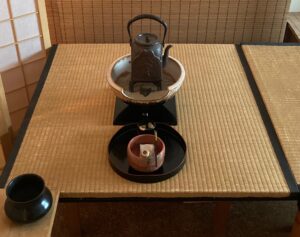
Arrangement of utensils for Bon-ryaku Ten-mae, 盆略点前, Tray-abbreviate Offer-fore. The Tea presentation was created by En-nō-sai, 円能斎, Circle-art-abstain, XIII Iemoto, Urasenke. Hot water is supplied by a tetsu-bin, 鉄瓶, iron-bottle, over a fire contained in a bin-kake, 瓶掛, bottle-hang, made by William Sōei Thrasher, Wellesley, Massachusetts. The binkake may be made of ceramic or metal. Heat is provided by a charcoal fire set in a bed of ash, or in modern times, an electric burner.
An important symbolic aspect of this presentation is the contrasting circle, In, 陰, Yin, receptive aspect of the tray and the square, Yō, 陽, Yang, penetrative aspect of the shiki-ita, 敷板, spread-board, that supports the brazier.
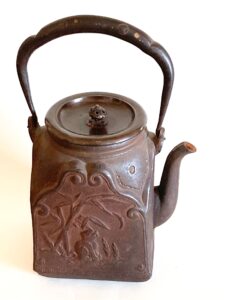
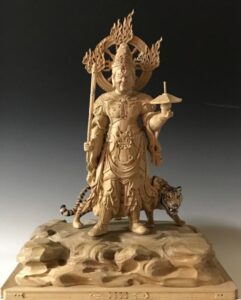
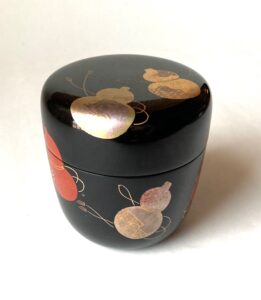
Chū-natsume, 中棗, middle-jujube, black lacquered, covered container with gold and colored lacquer design of Mubyō maki-e, 六瓢蒔絵, Six Gourds embed-picture, by Miya-ta Sō-kei, 宮田宗景, Palace-field Sect-view, Saba-e, 鯖江, Mackerel-port; H. 1.9 sun kane-jaku, choice of Tan-tan-sai, 淡々斎, Light-light-abstain, XIV Iemoto, Urasenke. Mu-byō, 六瓢, six-gourds, is wordplay on mu-byō, 無病, no-sickness.
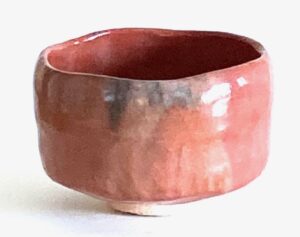
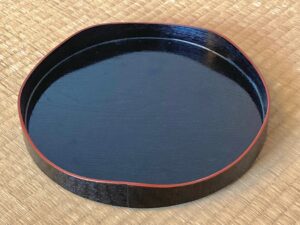
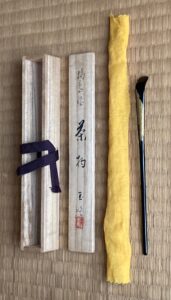
Cha-shaku, 茶杓, tea-scoop, susu-dake, 煤竹, smoke-bamboo, naka-bushi, 中節, middle-node, the back is lacquered black with a gold lacquer design of yanagi no eda, 柳の枝, willow’s branch, Wa-jima Nuri, 輪島塗, Ring-island Lacquer, by Gyoku-hō, 玉峰, Jewel-peak, Wajima. Shown with the yellow u-kon mo-men, 鬱金木綿, turmeric-gold tree-cotton, wrapper, and storage box.
The willow is represented in the tokonoma by the back left corner post, where the New Year willow branch is displayed on a special yanagi-kugi, 柳釘, willow-hook. The willow is identified with Kannon, who is also identified with the north. A thing is not just one thing.
![]()
Foundational study materials for concepts contained in this article can be found in:
Lecture 3: Five Elements and Ekikyō: Talk and Study Guide
Lecture 4: Animals and Guardians: Talk and Study Guide
Both lectures are contained in the Chanoyu: Anatomy of the Japanese Tea Ceremony, a lecture series developed and presented by Professor Allan Sōsei Palmer on the fundamental aspects underlaying the practice and appreciation of Chanoyu.

